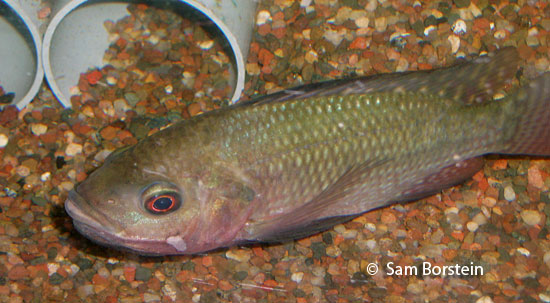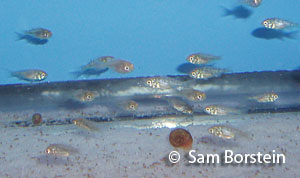Oreochromis niloticus baringoensis
Trewavas, 1983
Baringo Nile Tilapia
Synonyms: Oreochromis baringoensis, Tilapia baringoensis

Above: A male Oreochromis niloticus baringoensis displaying to a female. Photo by Sam Borstein.
Etymology:
Genus- Oreo= of mountains(Latin), chromis= a fish, perhaps a perch (Greek).
Species- niloticus= refers to nile river.
Subspecies- baringoensis= refers to Lake Baringo in Kenya.
Intro:
Oreochromis niloticus baringoensis is an extremely interesting and easy to breed mouthbrooding Tilapia. This fish is a subspecies of Oreochromis niloticus, the Nile Tilapia.
The eight sub species are:
- Oreochromis niloticus baringoensis
- Oreochromis niloticus cancellatus
- Oreochromis niloticus eduardianus
- Oreochromis niloticus filoa
- Oreochromis niloticus niloticus
- Oreochromis niloticus sugutae
- Oreochromis niloticus tana
- Oreochromis niloticus vulcani
Tilapia are amazing fish. They will eat anything and will breed under difficult circumstances. This fish can live in very low oxygenated waters, thrive in widely ranging of pH, and will survive in temperatures from 40 degrees to 110 degrees Fahrenheit. Because of this Tilapia that are introduced into non-native waters cause great damage to the native fish.
Distribution:
Oreochromis niloticus baringoensis is endemic to Lake Baringo in Kenya. This is a satelite lake of Lake Victoria.
Size, Maturity, and Sexual Dimorphism:
Size: Males- 12 inches, Females- 8 inches
Maturity: 4 inches
Sexual Dimorphism: Males are larger than females and are a lot more colorful than the females which are reddish-brown.

Above: A mouthbrooding female Oreochromis niloticus baringoensis. Photo by Sam Borstein.
Care:
This fish is easy to keep. Tilapia are extremely hard to kill. Almost all deaths will be from aggression. These fish can really be nasty towards each other. I believe that the mouthbrooding Tilapians are not as aggressive as the substrate spawning Tilapia. To manage their aggression I kept 8 in a 75 gallon tank, with no problems.
Since this fish gets pretty big, I recommend a 75 gallon for about 6-8 fish. These fish are messy eaters, so weekly water changes are a must.
Diet:
This fish will eat anything, and I mean anything. I have even seen them eat their own crap! These fish are bottomless pits, so feed them a lot. If you are looking to breed this fish, feed them food with more protein, as that will get the females into breeding condition faster.
Breeding:
This fish is extremely easy to breed. I got mine from fellow GCCA member Mike Helford. When I got home I put them in the tank and let them settle down. Eight hours later when I fed all my fish, I looked at the tank to see how they were doing, and to my surprise, they were breeding. I saw the female pick up egg after egg. This fish bred in less than 24 hours! That was amazing. The female held for about ten days, and when I stripped her I got about 150 1/4 inch free swimming fry. They have huge spawns, up to 350 eggs. What is amazing is two days later, that same female was holding again. The fry were easy to raise. I fed them sinking pellets, which they pecked at, and baby brine shrimp. They grew fast and were an inch by a month.
If you can't breed this fish here is what I recommend. See if you have all of one sex. If you have got a sausage fest, they aren't going to breed! If this isn't your case, well then you are doing something extremely wrong, and that would be amazing, because Tilapia are the easiest fish to care for!

Above: Oreochromis niloticus baringoensis fry. Photo by Sam Borstein.
This fish is pretty hard to find. I've never seen it for sale anywhere. I believe this is because people assume all Tilapia are the same. Ugly mean fish. Yes some are ugly and they are mean, but they are extremely interesting fish.
References:
- Lamboj, A. (2004). The Cichlid Fishes of Western Africa. Bergit Schmettkamp Verlag, Bornheim, Germany, 255 pp.
